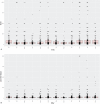HIV, HCV, HBV, and syphilis among transgender women from Brazil: Assessing different methods to adjust infection rates of a hard-to-reach, sparse population
- PMID: 29794601
- PMCID: PMC5991532
- DOI: 10.1097/MD.0000000000009447
HIV, HCV, HBV, and syphilis among transgender women from Brazil: Assessing different methods to adjust infection rates of a hard-to-reach, sparse population
Abstract
Different sampling strategies, analytic alternatives, and estimators have been proposed to better assess the characteristics of different hard-to-reach populations and their respective infection rates (as well as their sociodemographic characteristics, associated harms, and needs) in the context of studies based on respondent-driven sampling (RDS). Despite several methodological advances and hundreds of empirical studies implemented worldwide, some inchoate findings and methodological challenges remain. The in-depth assessment of the local structure of networks and the performance of the available estimators are particularly relevant when the target populations are sparse and highly stigmatized. In such populations, bottlenecks as well as other sources of biases (for instance, due to homophily and/or too sparse or fragmented groups of individuals) may be frequent, affecting the estimates.In the present study, data were derived from a cross-sectional, multicity RDS study, carried out in 12 Brazilian cities with transgender women (TGW). Overall, infection rates for HIV and syphilis were very high, with some variation between different cities. Notwithstanding, findings are of great concern, considering the fact that female TGW are not only very hard-to-reach but also face deeply-entrenched prejudice and have been out of the reach of most therapeutic and preventive programs and projects.We cross-compared findings adjusted using 2 estimators (the classic estimator usually known as estimator II, originally proposed by Volz and Heckathorn) and a brand new strategy to adjust data generated by RDS, partially based on Bayesian statistics, called for the sake of this paper, the RDS-B estimator. Adjusted prevalence was cross-compared with estimates generated by non-weighted analyses, using what has been called by us a naïve estimator or rough estimates.
Conflict of interest statement
The authors report no conflicts of interest.
Figures





References
-
- Joint United Nations Programme on HIV/AIDS (UNAIDS), 2017. Available at: http://www.unaids.org/sites/default/files/media_asset/20170720_Data_book... Accessed October 19, 2017.
-
- Joo J, Lebowitz JL. Behavior of susceptible-infected-susceptible epidemics on heterogeneous networks with saturation. Phys Rev E Stat Nonlin Soft Matter Phys 2004;69(part 2):066105. - PubMed
MeSH terms
Grants and funding
LinkOut - more resources
Full Text Sources
Other Literature Sources
Medical

